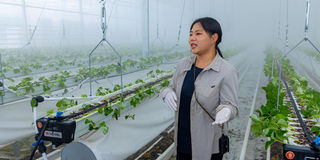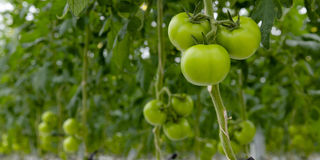Prime
Lessons from Korea’s smart agriculture

Shin-nara (23) is one of the Smart Farm students at the Smart Farm Innovation Valley in Korea. PHOTO | FILE
What you need to know:
- Smart farming is the future of agriculture. It allows farmers to be more efficient and productive while using fewer resources such as water, fertilisers and seeds
Smart farming is a concept that is gaining prominence in the agricultural sector, where modern tools, backed by innovation and technology, are used to increase yields and optimise productivity. Speaking to Seeds of Gold, Korea’s Minister of Agriculture, Food, and Rural Affairs, Chung Hwang-keun, shares more insights.
What are some of the challenges associated with smart farming?
Smart Agriculture is the key means to enable innovation in the agri-food industry and a stable supply of food through labour savings, enhanced productivity, and quality improvement in response to agricultural challenges including climate change and an aging society.
It also enhances the value addition of the agri-food industry, attracts young farmers, and creates new jobs by linking it with upstream and downstream machinery and solution industries.
However, high costs and a lack of information, the complexity and inaccuracy of technologies, and a lack of farmers’ understanding of technologies and equipment can be obstacles to the dissemination of smart agriculture.
While removing these obstacles, Korea plans to transform 30% of greenhouses and livestock barns into smart ones.
How has smart farming increased the supply of food for Korea? Has it also improved exports of agricultural produce? If so, what are the leading export products and destinations?
Smart agriculture has driven various changes in domestic agriculture and exports.
While achieving increased production and income and a decreased labour burden, smart agriculture has enabled Korea’s agriculture to respond to changing consumer demand and the market environment in and out of the country.
Compared to farms that have not adopted smart technologies, smart farms’ production was 32% higher and their income was 46% higher.
Smart agriculture has contributed to maintaining the competitiveness of Korea’s agricultural and livestock products in the current situation where consumer demand has changed, consumers are seeking high-quality products according to the rise in income level, and competition with imported agricultural products in terms of price and quality has become severe.
Through smart farming, the export competitiveness of Korea’s agri-food has been enhanced, leading to continued growth in the export of Korean agri-food.
Export volume of agri-food: $1.51 billion in 2000; $4.08 billion in 2010; $7.56 billion in 2020; $8.56 billion in 2021; and $8.82 billion in 2022.
Some of Korea’s leading agricultural exports produced on smart farms include strawberries and paprika. Export of strawberries: $58.6 million in 2022; $52.1 million in week 3 of June 2023 (increase by 26.5% year on year).
Paprika accounts for 90% of the imported paprika market share in Japan.
Export of paprika: $73.1 million in 2022; $30.2 million in week 3 of June 2023 (a decrease of 17% year on year).

What are the mechanisms put in place within the framework of agricultural cooperation with Africa?
Korea has been promoting various ODA projects, ranging from humanitarian food assistance to the development and distribution of agricultural technologies, based on its experience in achieving rice self-sufficiency with the development of the Tongil variety in the 1970s as well as in promoting agricultural and rural development through the Saemaul movement.
Korea, once a food assistance recipient, is now providing 50,000 tonnes of rice every year through the United Nations World Food Programme (WFP) from 2018. At the end of last year, Korea also provided 101 heifers and dairy technologies to Nepal in collaboration with Heifer, an international non-profit charity.
We are in close cooperation with African countries, focusing mainly on the expansion of agricultural infrastructure and productivity enhancement, including the modernisation of irrigation facilities and the distribution of high-yielding varieties. Also, we have strengthened cooperation with Southeast Asia in smart farming and agricultural development in an effort to boost farm income.
In addition, we are making great efforts to develop and transfer agricultural technologies suitable for local conditions by establishing KOPIA centres in 23 countries around the world.
Korea plans to double the scale of its ODA projects by 2027 to share its experience in agricultural development and make a significant contribution to resolving the food crisis in developing countries.
By establishing the K-rice belt in seven sub-Saharan African countries with low rice self-sufficiency rates, Korea will actively share its experience in achieving rice self-sufficiency with Africa in countries such as Ghana, Gambia, Guinea, Senegal, Uganda, Cameroon, and Kenya.
In this regard, Korea signed an MOU with seven African countries on July 10, 2023, which encompasses the construction of irrigation facilities, the distribution of new seed varieties suitable for local conditions, the provision of second-hand agricultural machinery, and support for post-harvest processing and distribution.
We will be able to ensure a stable supply of food for more than 30 billion people by producing 10,000 tonnes of rice seeds annually and providing them to farms to produce high-quality rice starting in 2027.
Furthermore, with the provision of domestic second-hand agricultural machinery and the construction of necessary infrastructure for repair and rental services, we will further facilitate the mechanisation of agriculture in developing countries.
Also, we will improve agricultural productivity and strengthen agricultural administration capabilities in developing countries supported by the establishment of digital agricultural infrastructure, technology transfer, and digitalised public administration.





